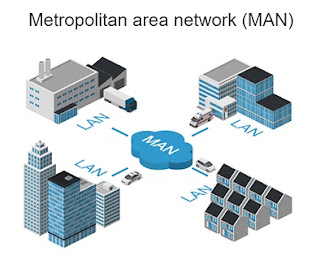On the basis of geographical area and speed there are three broad
categories of network
1. LAN (Local Area Network)
2. MAN ( Metropolitan Area Network)
3. WAN ( Wide Area Network)
LAN(Local Area Network): LAN is a type of network in which
computers (nodes) are connected in a local unit or small geographical area,
such as office, any department of a management system, Private Campus etc. The
common connecting media used in LAN are cables, Wi - Fi, etc. LANs are
restricted in size and are convenient to handle.
Characteristics of LAN
i)In
LAN, Data communication takes place at a rate of 100 – 1000 mbps.
ii) It
is owned by an individual or an organization
iii) It
provides the user with an access to share several common hardware resources. Ex-
computers, terminals, printers, server, etc.
MAN (Metropolitan Area Network)
MAN is a computer network designed for a town or city. It may be a single
network or may be a network that connects several LANs. MAN may be operated by
a single organization or by several organizations in the same city. Ex-
telephone lines, networking of a MNC, networking of various government
departments, etc. The communication media used in MAN can be wired or wireless.
Characteristics of MAN:
i) It
covers larger than LAN but smaller geographical area than WAN.
ii) It
is surrounded within a single city ot metropolitan area.
iii) It
is mainly owned by large Organizations to interconnect all its branch across a
city.
WAN (Wide
Area Network)
WAN is a type of network in which computers
are connected over large geographical area such as cities, states, countries or
even the whole world. Its purpose is establish connection to share information among
computers from one place to other globally.
The common example of WAN is “INTERNET”,
The communication medium used in WAN is mainly unguided media (satellites).
Characteristics of WAN
i) The speed of data transfer is up to 150mbps.
ii) It connects large geographical area at low cost.
iii)WAN between two or more network are connected
through ‘GATEWAY’ that establish connectivity between protocol used in one
network with the other network.
These Two more types of network used in now-a-days:
PAN (Personal Area Network)
PAN is a computer network that is functional around an
individual or is limited within a range of 10 meters. It is an interconnection
of several peripherals or devices such as laptop, smartphone, printers, etc.
Such Personal Area Network can be wired or wireless.
Bluetooth, Infrared are common examples of PAN. Bluetooth’s PAN are also
known as ‘Piconets’.
CAN (controller Area Network)
Controller Area Network is an ISO certified method of
communication between various electronic devices used for lighting control, air
conditioning, airbags, central locking embedded in a vehicle etc.





Comments
Post a Comment